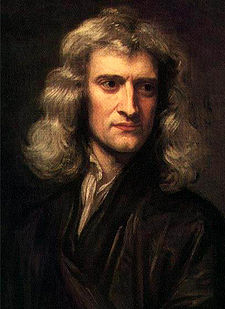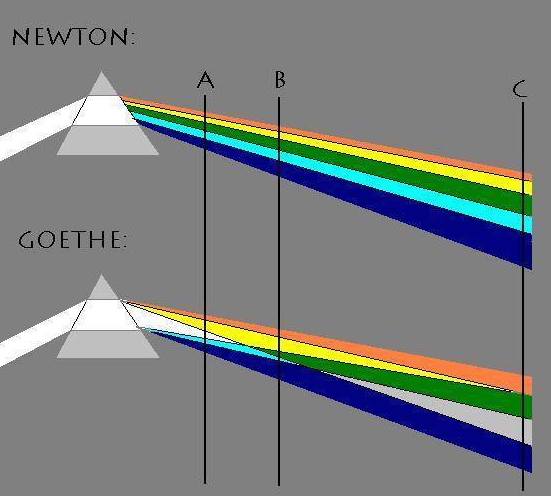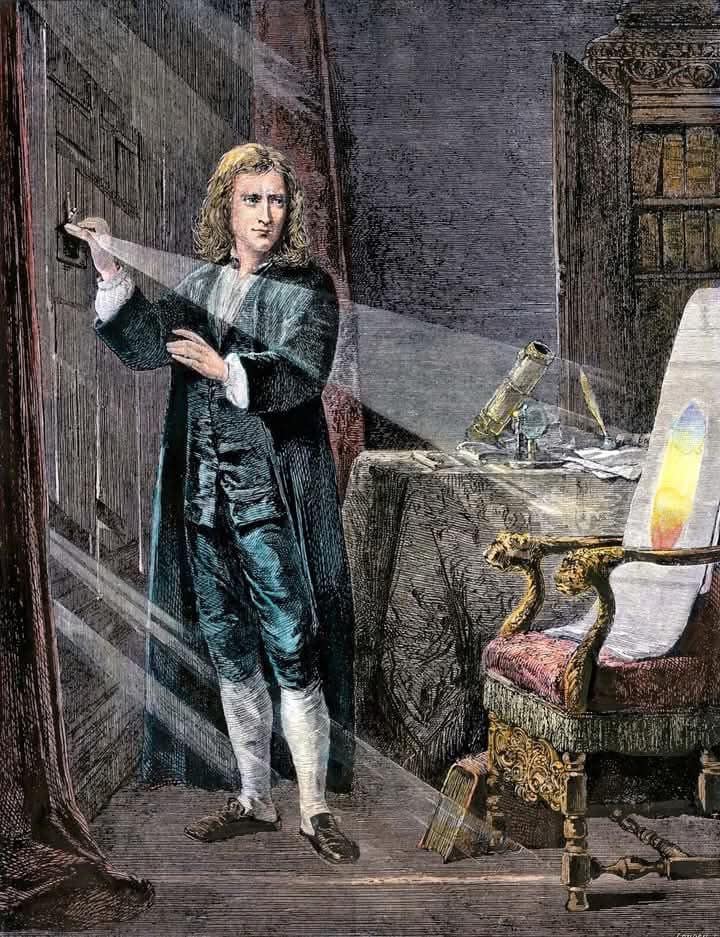
Sir Isaac Newton PRS (4 January 1643 - 31 March 1727 OS: 25 December 1642 - 20 March 1727) was an English physicist, mathematician, astronomer, natural philosopher, alchemist, and theologian, and is considered by many scholars and members of the general public to be one of the most influential people in human history. His Philosophiæ Naturalis Principia Mathematica (Latin for "Mathematical Principles of Natural Philosophy"; usually called the Principia), published in 1687, is one of the most important scientific books ever written. It lays the groundwork for most of classical mechanics. In this work, Newton described universal gravitation and the three laws of motion, which dominated the scientific view of the physical universe for the next three centuries. Newton showed that the motions of objects on Earth and of celestial bodies are governed by the same set of natural laws, by demonstrating the consistency between Kepler's laws of planetary motion and his theory of gravitation; thus removing the last doubts about heliocentrism and advancing the Scientific Revolution.
Newton built the first practical reflecting telescope and developed a theory of color based on the observation that a prism decomposes white light into the many colours that form the visible spectrum. He also formulated an empirical law of cooling and studied the speed of sound.
In mathematics, Newton shares the credit with Gottfried Leibniz for the development of differential and integral calculus. He also demonstrated the generalised binomial theorem, developed Newton's method for approximating the roots of a function, and contributed to the study of power series.
Newton was also highly religious. He was an unorthodox Christian, and during his lifetime actually wrote more on Biblical hermeneutics and occult studies than on science and mathematics, the subjects he is mainly associated with. (wikipedia)
Isaac Newton, as President of the Royal Society, did much to obscure Robert Hooke, including, it is said, destroying (or failing to preserve) the only known portrait of the man.Wikipedia, Robert Hooke
Isaac Newton, like Albert Einstein, is a quintessential symbol of the human intellect and its ability to decode the secrets of nature. Newton's fundamental contributions to science include the quantification of gravitational attraction, the discovery that white light is actually a mixture of immutable spectral colors, and the formulation of the calculus. Yet there is another, more mysterious side to Newton that is imperfectly known, a realm of activity that spanned some thirty years of his life, although he kept it largely hidden from his contemporaries and colleagues. We refer to Newton's involvement in the discipline of alchemy, or as it was often called in seventeenth-century England, "chymistry." Newton wrote and transcribed about a million words on the subject of alchemy. Newton's alchemical manuscripts include a rich and diverse set of document types, including laboratory notebooks, indices of alchemical substances, and Newton's transcriptions from other sources.
http://webapp1.dlib.indiana.edu/newton/
Sir Isaac Newton (1642-1727) for example is widely recognized as one of the most influential scientists of all time. He discovered gravity and the laws of motion that form the foundation much of modern physics. Newton was deeply convinced that nature provides overwhelming scientific proof of God. His book ‘Mathematical Principles of Natural Philosophy‘ laid the foundations for classical mechanics. Appended to this book, Newton wrote an essay called ‘The General Scholium’, in which he stated:
‘This most beautiful system of the sun, planets, and comets, could only proceed from the counsel and dominion of an intelligent being. And if the fixed Stars are the centers of other like systems, these, being formed by the like wise counsel, must all be subject to the dominion of One. … This Being Governs all things, not as the soul of the world, but as Lord over all.’
When Sir Isaac Newton tried to poke his own eye with a needle
Newton believed in observing rather than reading. Even though Isaac Newton was an avid reader and used to spend hours studying in his room, he believed that true discovery happens and knowledge is built more by observations.
There’s an incident where he once tried to poke his eye with a needle to see what happens to his vision.
This incident is one of the most famous examples of scientific self-experimentation in history. Isaac Newton, the renowned physicist and mathematician, wanted to investigate the nature of light and color by directly stimulating his own retina. He did this by inserting a bodkin, a long sewing needle with a blunt point, into his eye socket, between his eye and the bone, and applying pressure until he saw various patterns and colors. He recorded his observations in his book Opticks, published in 1704.
Newton’s experiment was very risky and could have caused permanent damage to his vision. However, he was not deterred by the pain or the danger, as he was driven by a curiosity to understand the workings of the eye and the brain. He also repeated the experiment several times with different angles and pressures. Newton’s experiment showed that the colors we see are not inherent in the objects themselves, but are produced by the interaction of light with our eyes. He also discovered that white light is composed of different colors that can be separated by a prism. Newton’s experiment was a remarkable demonstration of his ingenuity and courage, and madness, as well as his contribution to the field of optics.
Keely
"Fichte writes: "The will is the living principle of the world of spirit as motion is of the world of sense." Newton said that this subtle ether interpenetrates all matter and is concealed in their substance, through the strength and activity of which, bodies attract each other and adhere together when brought in contact, annihilating distance, as if objects might touch each other. Through this "life spirit" light also flows, is refracted and reflected and bodies are warmed. Pythagoras viewed this as a divine luminous principle or substance which permeates all things and at the same time contains all things. They called it the astral light. The Germans call it the "Welgeist". [Snell Manuscript - The Book, page 2]
Newton, who scoffed at Epicurus's idea that "gravitation is essential and inherent in matter," asserted that gravity must be caused by an agent acting, constantly, according to certain laws. Heat, gravity, light, electricity, magnetism, chemical affinities, are all different phases of the primal force discovered by Keely, and all these forces, it is said, can be obtained from a single ray of sunlight. "The evidence of unity or oneness even between the physical, vital, mental, and spiritual is seen in the light of this law of correlation," says J. J. Smith. "A great portion of our muscles contract and relax in obedience to our wills, thereby proving that the mental force can be, and is, in every such instance actually converted into the muscular or the physical." Keely demonstrates the truth of this assertion, claiming that "all forces are indestructible, immaterial, and homogeneous entities, having their origin and unity in one great intelligent personal will force." [The Key to the Problems. - Keelys Secrets]
Goethe’s commentary on Newton
“It may be boldly asked where can the man be found, possessing the extraordinary gifts of Newton, who could suffer himself to be deluded by such a hocus-pocus, if he had not in the first instance willfully deceived himself; Only those who know the strength of self-deception, and the extent to which it sometimes trenches on dishonesty, are in a condition to explain the conduct of Newton and of Newton’s school. To support his unnatural theory Newton heaps fiction upon fiction, seeking to dazzle where he cannot convince. In whatever way or manner may have occurred this business, I must still say that I curse this modern history theory of Cosmology, and hope that perchance there may appear, in due time, some young scientists of genius, who will pick up courage enough to upset this universally disseminated delirium of lunatics.”
“Someday someone will write a pathology of experimental physics and bring to light all those swindles which subvert our reason, beguile our judgement and, what is worse, stand in the way of any practical progress. The phenomena must be freed once and for all from their grim torture chamber of empiricism, mechanism, and dogmatism; they must be brought before the jury of man’s common sense.” [Johann Wolfgang von Goethe]

Keely
Sir Isaac Newton in his "Fundamental Principles of Natural Philosophy" calls the magnetic agent "the soul of the world." [Snell Manuscript - The Book, page 2]
Schauberger
In reality there are two mutually opposed fermentation processes (forms of inner motion) that determine what is to be created from these allotropic (polymorphic) fat-concentrates entombed in the Earth along with the cadaver. Decomposive and retrogressive energies - the above ptomaine radiation - are active here, which are generated when the reversed fermentation process that produces positively charged acids is triggered by thermal influences which intensify internal - rupturing - pressures. This is further exacerbated by the disintegrative effect of mechanics, which bio-logic-ally speaking gives rise to reactivated centrifugal motion. It thus becomes clear that in Nature there are neither equivalencies, nor any constant conservation of energy or matter, but only differentiations, which mutually potentiate one another. Robert Mayer, Isaac Newton and others devoid of intuition - therefore nature-alienated lawmakers - have seriously erred (exact proof of this exists) inasmuch as in an eternally changing Nature there are actually no rigid laws, no domas or absolutes, but only a rhythmical interplay of energies, which determine the fate of all existence.[17] This is because the products of this interplay, already in an atomic state, have an in-built capacity to react, and are therefore products of bio-logical development. [The Energy Evolution - Harnessing Free Energy from Nature, Cadaverine Poison in Ray-Form - Ptomaine Radiation]
[17] In relation to Newton's discovery of the laws of gravity, Viktor Schauberger comments: "I think it would have been much better if Newton had contemplated how the apple got up there in the first place!" [Implosion Magazine, No. 35, p 16. — Ed.] [The Energy Evolution - Harnessing Free Energy from Nature, Cadaverine Poison in Ray-Form - Ptomaine Radiation]

Isaac Newton, born on December 25, 1642 (Julian calendar) or January 4, 1643 (Gregorian calendar) in Woolsthorpe, England, is one of the most influential figures in the history of science. His work not only transformed physics but also laid the foundation for modern scientific inquiry.
Newton’s Three Laws of Motion
These laws, published in his seminal work Philosophiæ Naturalis Principia Mathematica (1687), are the cornerstones of classical mechanics, explaining the relationship between the forces acting on an object and its motion.
1. First Law: Law of Inertia
"An object will remain at rest or in uniform motion in a straight line unless acted upon by an external force."
This law was revolutionary because it contradicted Aristotelian physics, which held that objects naturally come to rest. It introduced the concept of inertia, a property of matter to resist changes in motion.
2. Second Law: F = ma
"The acceleration of an object is directly proportional to the net force acting upon it and inversely proportional to its mass."
This law quantifies motion, providing a mathematical framework to calculate how forces affect motion. The equation F=ma (Force equals mass times acceleration) is widely applied in physics and engineering.
3. Third Law: Action and Reaction
"For every action, there is an equal and opposite reaction."
This principle explains interactions between objects, such as the recoil of a gun or the propulsion of a rocket.
Broader Contributions
1. Universal Gravitation: Newton’s law of universal gravitation posits that every mass attracts every other mass with a force proportional to their masses and inversely proportional to the square of the distance between their centers. This unified terrestrial and celestial mechanics.
2. Calculus: Newton co-developed calculus (independently of Leibniz), a mathematical tool crucial for describing motion, change, and dynamic systems.
3. Optics: He conducted pioneering work on the nature of light, showing that white light is composed of a spectrum of colors.
Context and Legacy
Newton was born during a tumultuous time in England, shortly after the English Civil War began. Despite these challenges, his genius flourished. He synthesized the works of predecessors like Copernicus, Kepler, and Galileo, ushering in the Scientific Revolution.
His principles governed physics for nearly 200 years until Einstein’s theories of relativity introduced new paradigms for high velocities and gravitational fields.
Fun Fact
Although born on Christmas Day under the Julian calendar, the Gregorian calendar shifted his birthdate to January 4, aligning with modern reckoning.
Newton’s insights remind us of the profound power of curiosity and rigorous thinking—gifts as enduring as the holiday season itself!
image: Isaac NewtonIsaac Newton dispersing sunlight through a prism, engraving after a picture by J.A. Houston, published c. 1879.
See Also
Ether - Newton
John Wilkins
Newton Laws of Motion
Newton of the Mind
Newtonian
Non-Newtonian
Principia
Robert Hooke
Sympathetic Vibration v Newtonian Physics
Thomas Willis
